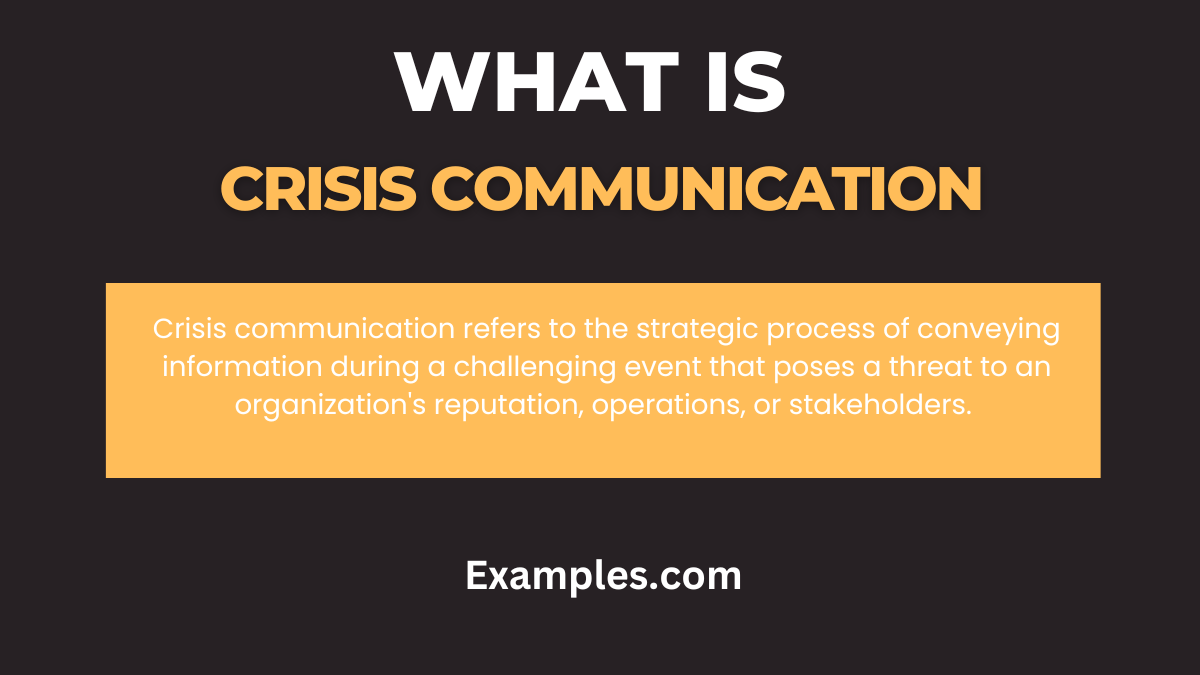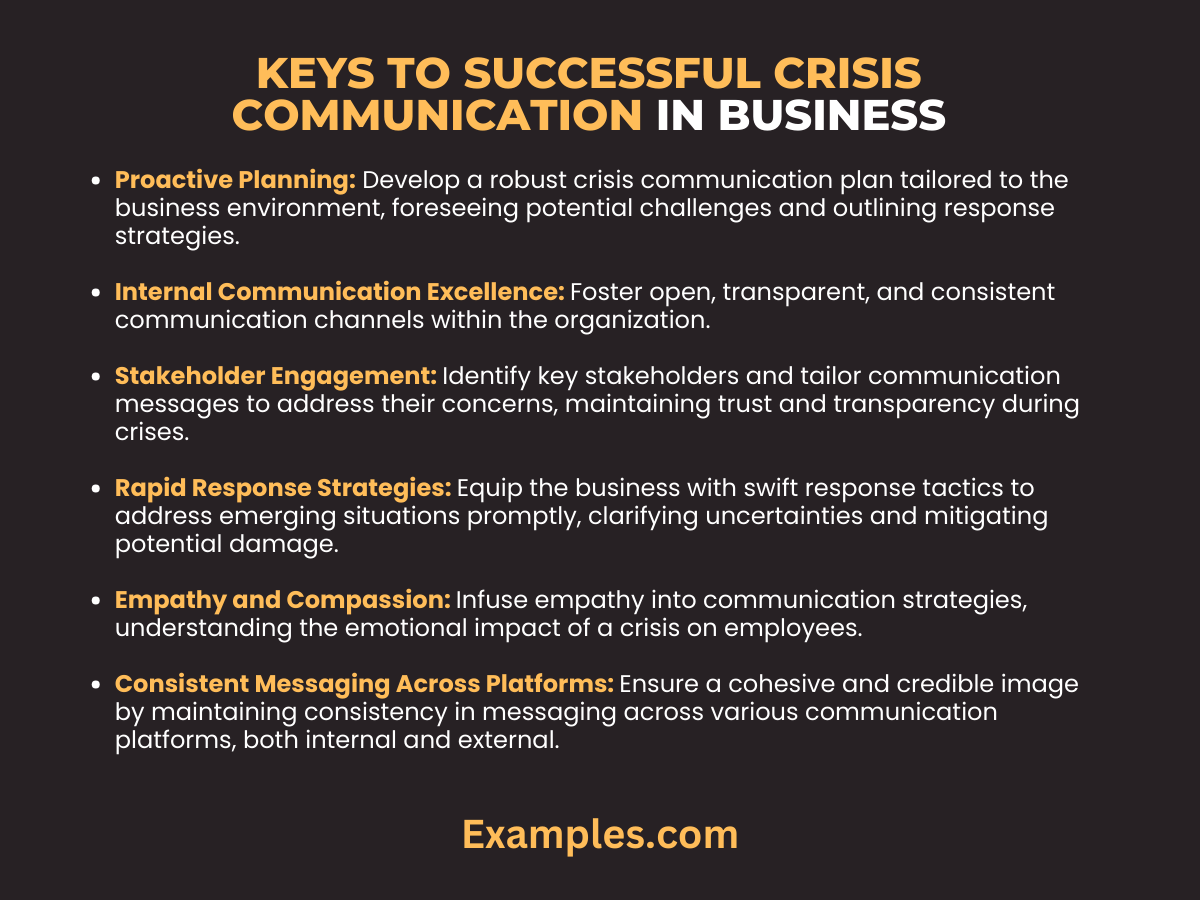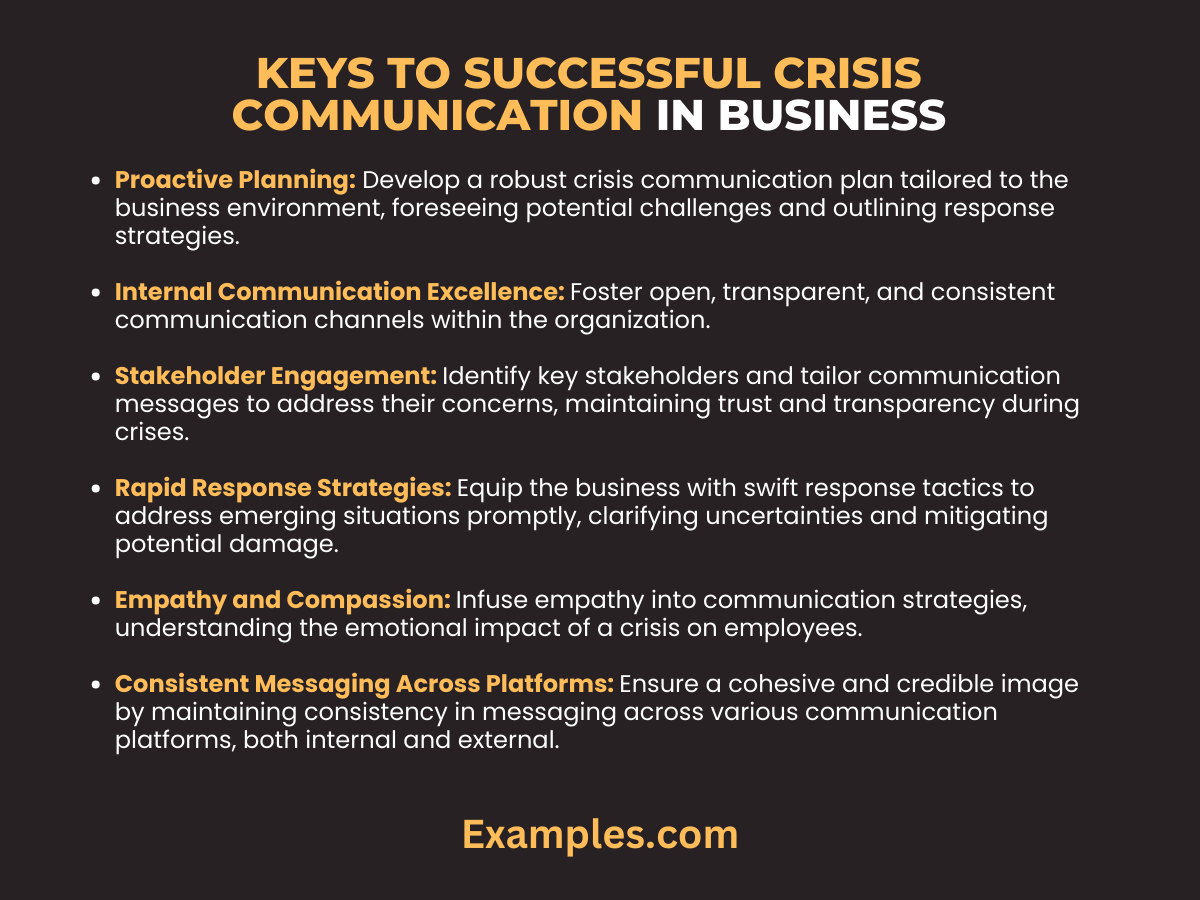Keys to Successful Crisis Communication – 19+ Examples
Unlock the secrets of effective crisis management with our comprehensive guide on the Keys to Successful Crisis Communication. Delve into the definition, explore historical perspectives, and gain insights from impactful examples. Learn the origins of successful crisis communication, discover invaluable tips, and master the art of navigating challenges. Whether you’re a business leader or communicator, this guide provides essential know-how, practical examples, and actionable tips for steering through turbulent times with confidence.
What is Crisis Communication?

Crisis communication refers to the strategic process of conveying information during a challenging event that poses a threat to an organization’s reputation, operations, or stakeholders. It involves clear, timely, and transparent messaging to manage the impact of crises, ensuring an organization can effectively address challenges and maintain public trust. This communication discipline aims to minimize harm, restore confidence, and navigate turbulent situations with integrity.
20 Keys to Successful Crisis Communication

Navigating crises requires adept communication strategies. Explore these key examples for effective crisis management:
- Preparedness Planning: Developing a detailed crisis plan to anticipate and manage potential issues proactively. Communicate by conducting scenario-based drills and refining response strategies regularly.
- Transparent Communication: Openly sharing information to build trust and credibility. Communicate by promptly addressing concerns with clear and honest messages.
- Rapid Response: Swiftly addressing crises to prevent escalation. Communicate by having a designated spokesperson to ensure immediate, accurate information dissemination.
- Empathy and Apology: Expressing genuine concern and issuing sincere apologies when required. Communicate by acknowledging mistakes and expressing genuine remorse.
- Consistent Messaging: Ensuring uniformity in information across all communication channels. Communicate by aligning all statements and responses for coherence.
- Stakeholder Engagement: Involving and considering stakeholders in communication efforts. Communicate by addressing their needs and concerns directly.
- Media Management: Effectively handling media inquiries and interactions. Communicate by providing factual information and maintaining composure.
- Real-Time Monitoring: Constantly monitoring situations to adapt communication strategies. Communicate by staying vigilant and responsive.
- Factual Accuracy: Delivering verified information to prevent misinformation. Communicate by fact-checking before sharing any details.
- Post-Crisis Evaluation: Analyzing responses to improve future crisis management. Communicate by conducting thorough assessments and implementing necessary changes.
- Adjustment Communication: Modifying communication approaches based on the crisis nature. Communicate by customizing messages to suit diverse situations.
- Reputation Management: Protecting and rebuilding the organization’s image. Communicate by demonstrating commitment and corrective actions.
- Internal Communication: Engaging and informing internal stakeholders for coordinated efforts. Communicate by fostering a culture of open dialogue.
- Social Media Management: Monitoring and responding to social media conversations adeptly. Communicate by actively engaging and addressing concerns.
- Instructional Communication: Providing clear instructions during crises for user guidance. Communicate by outlining step-by-step actions for stakeholders.
- Post-Crisis Communication: Delivering follow-up messages to update on recovery efforts. Communicate by ensuring stakeholders remain informed post-crisis.
- Crisis Communication in Healthcare: Tailoring communication strategies to address health-related crises effectively. Communicate by prioritizing patient safety and well-being.
- Crisis Communication in Business: Crafting communication tactics suitable for corporate crises. Communicate by ensuring business continuity and stakeholder confidence.
- Crisis Communication in Organizations: Implementing communication approaches specific to organizational crises. Communicate by addressing internal and external concerns.
- Crisis Communication in Higher Education: Deploying effective strategies in educational crisis situations. Communicate by ensuring transparency and student safety.
Keys to Successful Crisis Communication in Business

Effective crisis communication in the business realm demands finely-tuned communication skills. Mastering the following keys ensures a proactive and adept approach to managing crises within the corporate landscape:
- Proactive Planning: Develop a robust crisis communication plan tailored to the business environment, foreseeing potential challenges and outlining response strategies.
- Internal Communication Excellence: Foster open, transparent, and consistent communication channels within the organization, ensuring all team members are well-informed and prepared for crisis scenarios.
- Stakeholder Engagement: Identify key stakeholders and tailor communication messages to address their concerns, maintaining trust and transparency during crises.
- Rapid Response Strategies: Equip the business with swift response tactics to address emerging situations promptly, clarifying uncertainties and mitigating potential damage.
- Empathy and Compassion: Infuse empathy into communication strategies, understanding the emotional impact of a crisis on employees, stakeholders, and the broader community.
- Consistent Messaging Across Platforms: Ensure a cohesive and credible image by maintaining consistency in messaging across various communication platforms, both internal and external.
- Real-Time Monitoring and Adaptation: Leverage technology for real-time monitoring of potential crises, allowing the business to adapt strategies swiftly in response to evolving situations.
- Transparent Communication Practices: Develop and uphold transparent communication practices, especially during unforeseen events, fostering trust and understanding among stakeholders.
- Factual Accuracy and Precision: Communicate with precision and accuracy, avoiding misinformation and ensuring that messages relayed during crises are verified and trustworthy.
- Post-Crisis Evaluation: Conduct a comprehensive evaluation post-crisis to analyze communication strategies’ effectiveness, identify areas of improvement, and implement lessons learned for future readiness.
Keys to Successful Crisis Communication in the Workplace
Effective crisis communication is pivotal in maintaining organizational resilience. Sharpen your communication skills with these key strategies tailored for the workplace:
- Proactive Planning: Foster a culture of preparedness by anticipating potential crises. Develop robust communication plans and scenarios for quick response.
- Internal Communication Excellence: Build transparent and open channels for internal communication. A well-informed team enhances crisis response efficiency.
- Stakeholder Engagement Mastery: Tailor messages to resonate with diverse stakeholders. Address concerns and expectations to maintain trust during crises.
- Rapid Response Tactics: Develop swift response mechanisms for immediate clarification and resolution. Timeliness is crucial in crisis communication.
- Empathy and Emotional Intelligence: Infuse empathy into communication strategies. Understand the emotional impact of crises on employees and respond compassionately.
- Clear and Consistent Messaging: Practice clear and consistent communication. Avoid jargon, ensuring all employees easily understand crisis messages.
- Real-Time Monitoring and Response: Leverage technology for real-time crisis monitoring. Swiftly respond to emerging situations, showcasing agility in communication.
- Transparent Communication Guidelines: Develop and adhere to transparent communication guidelines. Authenticity builds credibility during workplace crises.
- Factual Accuracy Assurance: Share verified and accurate information with employees. Factual accuracy is paramount for trust-building in the workplace.
- Post-Crisis Evaluation Insights: Conduct comprehensive evaluations post-crisis. Learn from experiences to refine crisis communication strategies for future resilience.
What are the keys to successful crisis communication?
Navigating a crisis demands a nuanced approach to communication. Discover the essential keys to successful crisis communication, honing skills that can make a pivotal difference.
Proactive Planning: Explore the significance of anticipating potential crises, outlining key messages, and designating communication roles in advance.
Internal Communication Excellence: Foster open and transparent channels within your organization, ensuring a well-informed internal team as a foundation for external crisis communication.
Tailoring Messages to Stakeholders: Identify and understand your key stakeholders, mastering the art of crafting messages that resonate with diverse audience groups.
Real-Time Monitoring and Response: Leverage technology for real-time monitoring of potential crises, enabling swift responses and demonstrating proactive communication.
Consistency Across Platforms: Build credibility by ensuring consistency in messaging across various communication platforms, from internal memos to public statements.
Infusing Empathy and Emotional Intelligence: Understand the emotional impact of a crisis on stakeholders and respond with genuine concern and compassion.
Clear and Concise Messaging: Practice clear and concise communication, avoiding jargon and ensuring that messages are easily understood by all audiences.
Social Media Management Strategies: Develop social media guidelines for crisis situations, efficiently managing and responding to social media conversations.
Media Relations Mastery: Train key personnel for effective media interactions, navigating media inquiries with poise and providing accurate information.
Post-Crisis Evaluation: Conduct a comprehensive evaluation post-crisis, learning from the experience and implementing improvements for future crisis responses
In conclusion, mastering the keys to successful crisis communication is paramount for navigating uncertainties. By embracing transparency, empathy, and strategic planning, organizations can effectively weather crises. These principles, illustrated by diverse examples, offer a comprehensive guide for building resilience and maintaining trust in the face of adversity. Remember, crisis communication is an ongoing journey of adaptation and responsiveness.



